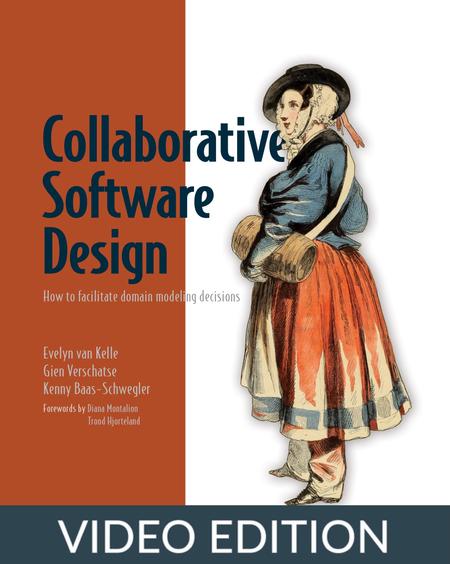English | MP4 | AVC 1280×720 | AAC 44KHz 2ch | 14h 53m | 2.73 GB
Emerging practices, collaboration tools, and effective techniques for incorporating your key stakeholders into the software design process.
Don’t spend months building the wrong software! Collaborative Software Design is a unique and practical guide for effectively involving all stakeholders in the design of software to ensure sustainable design decisions.
In Collaborative Software Design you’ll learn how to:
- Prepare and facilitate collaborative modeling sessions with tools such as Business Model Canvas, Event Storming,
- Domain Storytelling, Example Mapping, and Wardley Mapping
- Pick and apply heuristics for modeling software design
- Techniques for getting all needed knowledge from the group
- The influence of ranking
- The impact and opportunities of cognitive bias
- Resistance and conflict resolution
- Practices for following up after a modeling session
- Document the session and report to stakeholders
Collaborative Software Design combines its authors’ deep experience in behavioral science, decision-making theory and software architecture into an essential guide for making collaborative design decisions. You’ll learn to use process visualizations, engaging sessions, and social dynamic management to ensure every stakeholder is contributing their vital insights to a project. Best of all, the skills you’ll learn make it easy for software teams to develop software directly with their stakeholders—no need to rely on a centralized or top-down design.
Delivering high-quality software requires the active participation of all stakeholders in the design process. But how do you align individuals with different roles, perspectives, and priorities to create sustainable software? Collaborative Software Design presents proven strategies that you can use to foster productive decision making, resolve conflicts and uncertainties, and elevate the quality of design outcomes.
In Collaborative Software Design, you’ll explore principles, techniques, and tools to promote safe communication as you discover business problems, formalize requirements, and implement a software project. It highlights established collaborative modeling tools like Event Storming, Example Mapping, Wardley Mapping, and Domain Storytelling, and introduces unique approaches for managing cognitive biases, conflict, and organizational hierarchy. Whether you’re a business stakeholder, a technical contributor, or a professional facilitator, you’ll learn how to hear and benefit from every voice in the room.
What’s inside
- Prepare and lead collaborative modeling sessions
- Turn conflict into innovation
- Make sustainable software design decisions
- Improve software design from a sociotechnical perspective
Table of Contents
Chapter 1. The need for collaborative software design
Chapter 1. BigScreen: How collaborative modeling helped to improve design decisions
Chapter 1. Collaborative software design as a catalyst for better design decisions
Chapter 1. Summary
Chapter 2. What is collaborative modeling?
Chapter 2. Domain-Driven Design and collaborative modeling
Chapter 2. Different collaborative modeling tools
Chapter 2. Collaborative software design catalysts
Chapter 2. Further reading
Chapter 2. Summary
Chapter 3. Using collaborative modeling for design and architecture
Chapter 3. Heuristics for collaborative modeling
Chapter 3. Driving the design by understanding the business
Chapter 3. Collaborative software design catalysts
Chapter 3. Chapter heuristics
Chapter 3. Further reading
Chapter 3. Summary
Chapter 4. The ingredients of collaborative modeling
Chapter 4. Preparing for a session
Chapter 4. Sensemaking
Chapter 4. Check-in and check-out
Chapter 4. Different collaboration styles for modeling with tools
Chapter 4. Retrospective
Chapter 4. Collaborative software design catalysts
Chapter 4. Chapter heuristics
Chapter 4. Further reading
Chapter 4. Summary
Chapter 5. Facilitating collaborative modeling
Chapter 5. The core competencies of a facilitator
Chapter 5. Skill set of a facilitator
Chapter 5. Facilitating sensemaking and collaborative styles
Chapter 5. Dealing with remote facilitation
Chapter 5. Collaborative software design catalysts
Chapter 5. Chapter heuristics
Chapter 5. Further reading
Chapter 5. Summary
Chapter 6. The influence of ranking
Chapter 6. Becoming aware of ranking during collaboration and software design
Chapter 6. Facilitating ranking
Chapter 6. Collaborative software design catalysts
Chapter 6. Chapter heuristics
Chapter 6. Further reading
Chapter 6. Summary
Chapter 7. The effect and opportunities of cognitive bias
Chapter 7. Cognitive bias during collaboration and software design
Chapter 7. Facilitating cognitive bias
Chapter 7. Collaborative software design catalysts
Chapter 7. Chapter heuristics
Chapter 7. Further reading
Chapter 7. Summary
Chapter 8. Resistance and conflict resolution
Chapter 8. Resistance and conflict during collaboration
Chapter 8. Facilitating toward a resolution
Chapter 8. Collaborative software design catalysts
Chapter 8. Chapter heuristics
Chapter 8. Further reading
Chapter 8. Summary
Chapter 9. Making sustainable design decisions
Chapter 9. Decision-making styles and levels of buy-in
Chapter 9. Facilitating sustainable design decisions
Chapter 9. Collaborative software design catalysts
Chapter 9. Chapter heuristics
Chapter 9. Further reading
Chapter 9. Summary
Chapter 10. Managing unsolvable problems
Chapter 10. Visualizing a polarity
Chapter 10. Managing polarities during collaborative modeling
Chapter 10. Collaborative software design catalysts
Chapter 10. Chapter heuristics
Chapter 10. Further reading
Chapter 10. Summary
Chapter 11. Communicating and documenting decisions
Chapter 11. Spreading the knowledge through the company
Chapter 11. Keeping the decision alive
Chapter 11. Collaborative software design catalysts
Chapter 11. Chapter heuristics
Chapter 11. Further reading
Chapter 11. Summary
Chapter 12. Collaborative modeling beyond software design
Chapter 12. Collaborative modeling beyond software design
Chapter 12. Moving toward implementation
Chapter 12. Collaborative software design catalysts
Chapter 12. Chapter heuristics
Chapter 12. Further reading
Chapter 12. Summary
Appendix A.
Resolve the captcha to access the links!
